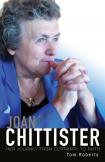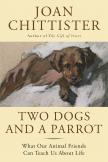A World Embrace
In the final chapter of Joan Chittister: Her Journey From Certainty to Faith, Joan Chittister, O.S.B., advises religious communities to ponder the following questions about the future of religious life: “Is there energy of heart shining out of the eyes there? Is there a pounding commitment to a wild and unruly gospel there? Is the spiritual life aglow there? Is there risk there? Is there unflagging commitment, undying intensity, unequivocal determination to be what I say I am? Or has the old glow gone dull? Is life now simply a matter of enduring days and going through the motions? Or is religious life in a brand new arc demanding more discipline from me and giving more life through me than ever?” Are those who live outside of religious communities also living in a time that demands more from us and promises more as well? I believe that we are and that we, too, can make good use of her questions. In a time that demands an enlightened response to devastating crises like mass inequality, ecological collapse and mass migration due to impoverishment, war and climate change, let us drink deeply from the well of Chittister’s wisdom.
It’s obvious that Joan Chittister: Her Journey From Certainty to Faith was a labor of love for its author, Tom Roberts. Roberts, editor at large of The National Catholic Reporter, claims that the book had an “unexpected beginning.” He had initially met with the author to update N.C.R.’s files, but a series of extended interviews summoned forth a story that needed to be told, written and shared. “Tell me,” he asks Chittister, “who are you and where do you come from?” Master meets master, I thought, as I read those questions and eagerly awaited her response. Roberts deftly manages to both appear and disappear from the book. He fully intends for the book’s reader to be immersed in the life, thought and work of Chittister and graciously gives her plenty of room to breathe life into this story. At the same time, he asks intelligent questions, is an astute chronicler of the events in her familial and religious life and is widely read in the history of the Erie Benedictines and of the Catholic Church in the 20th and 21st centuries. We are the beneficiaries of this love story, and for that I am most grateful.
Though I have been a lifelong reader of Chittister’s writings, Roberts’s book was one I did not know I needed to read until after I had done so. He illuminates well the diamond-like quality of Chittister’s insights in a cogent and lively narrative, which also amplifies the beauty and depth of her life and faith. From the first chapter, “The Light of God,” the reader is privy not only to the central questions that animate Chittister’s life but also to a mind and heart that have sought, often in ways that are hard-won, to live the always evolving answers to the questions. Who is God? To this she responds: “The God I knew lived in the light and the light I could feel was inside of me. Then all the thinking stopped and the knowing began, and the light burned the puny, punitive, paltry images away.” It is fitting, then, that the final chapter of the book is titled “Into Uncharted Waters,” a place for grown up men and women.
The book’s remaining chapters document well the rich contours of Chittister’s life: her intellectual gifts, an evolving and deepening faith, the intimacy of friendship and community life, the rigors and rewards of community-based leadership and the clarity of her commitment to social justice. In the mid-section of the book, which describes in detail the sometimes agonizing process of renewal within the Erie Benedictine community, Chittister remains clear-eyed. When the Marist brother Ronald Fogarty, a counselor specializing in change and renewal, visited the community and reminded its members that many great abbeys had closed or were headed in that direction, Chittister wrote: “The myth of immutability disappeared before our eyes.” Indeed, her insight and acceptance of reality are things that we may all wish to contemplate in this era of climate change and mass extinction. She goes on, however, to ask, “If religious life as we have known it is dead, what do we want to be caught dead doing?” She wanted, of course, to follow Jesus, the liberator and the healer.
Toward the end of the book, amid collapsing religious communities and societal institutions, Chittister constantly asks, “What do people need?” Her effort to answer this question immerses her deeply in the world of global peace and social justice efforts as well as face-to-face encounters with impoverished and marginalized peoples. Amid the turbulence and terror of the world, one is keenly aware of her resilience and an effort to find places of unity among people. A Hindu friend noted that Chittister “brings the depth of tradition and the ability to reach the deepest places within a specific tradition. Yet, she can still see the universality of it. She can sit with a Buddhist nun and she can see the common points between them.”
That we are people in need of everything on which Chittister sets her sights—intimate and authentic human encounters, inclusion and not exclusion and resilience—is evident in her work involving the matter of climate change. Chittister well understands what Pope Francis demonstrates in his encyclical “Laudato Si”: the need to reframe our relationship to the earth and its animal inhabitants, as well as to restructure capitalism, an economic system that promotes what in light of climate change appears to be a suicidal form of profit-making and consumerism. Chittister writes beautifully of a reframed relationship with the earth and animals in her book, Two Dogs and a Parrot: What Our Animal Friends Can Teach Us About Life.
Far from a collection of anecdotal pet stories—something Chittister first had in mind when she thought about writing this book—this volume speaks to nonseparation from and communion with animals. There is the delightful story of Danny, the Irish setter, who, after escaping from the yard of the abbey, has a marvelous time placing his paw repeatedly on the entryway mat of a local grocery shop, making the door open and close. The excitement of the dog is infectious: Yes, indeed, go out and live your life with great enthusiasm. There is also, in the final chapter of the book, a call to rethink our fixation with hierarchical relationships, both in the social world and in the natural world. Hierarchies, which “argue for inequality,” are a form of violence, create unnecessary suffering and cheat us of an opportunity to live fully with all of God’s creation.
Joan Chittister and Two Dogs and a Parrot are letters to the world and a must-read, particularly in light of the social and ecological collapse we are now facing. Chittister is clear-eyed in the dark woods and well capable of helping communities make it up to the mountaintop. Tom Roberts provides an excellent synthetic account of her life and thought; Chittister, like Pope Francis, encourages us to open wide our embrace and love of the earth, including its animals. Both books invite the reader to live as never before, and this reader is grateful for the chance to awaken.
This article also appeared in print, under the headline “A World Embrace,” in the August 15-22, 2016, issue.









